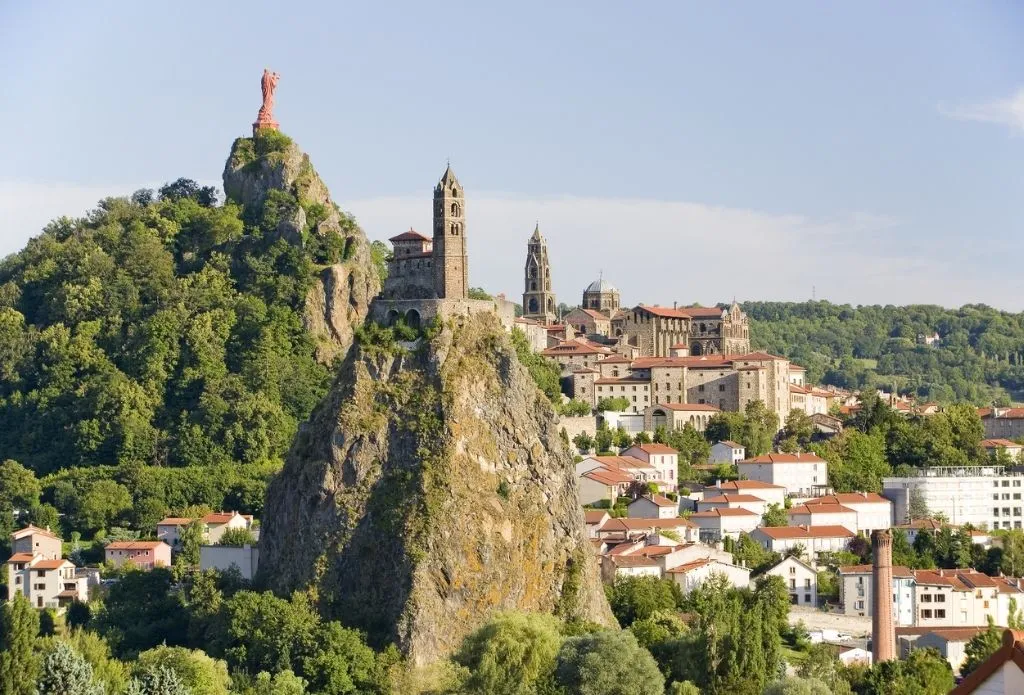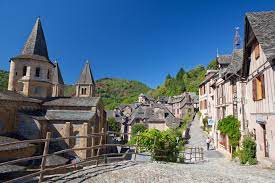
The Way of St James – Le Puy to Conques Via Podiensis
Traverse the centuries of time and the borders of Europe on the medieval pilgrim trail of Compostela. In the 9th century, the tomb of the apostle St James was unearthed in Compostela. The site became the focus of a pilgrim trail beginning in France, and crossing northern Spain to Santiago de Compostela. This journey, along the Via Podiensis, the French Way of St James, takes pilgrims from Le Puy en Velay to the Pyrenees at St Jean Pied de Port. The route passes a multitude of churches and monasteries, resembling a travelling museum of Romanesque art. Seven stages of this historic trail are included in our self-guided walking program in France. This section begins in the centre of France, on the Central Massif at Le Puy-en Velay where many trails from across Europe converged en route to the tomb of St James in Spain. The trail ascends the volcanic highlands of Margeride in the Haute Loire before continuing through the traditional granite villages of the Lozere. Continuing through the Aveyron, the final destination is the enchanting town of Conques. The presence of stone chapels and the unique crosses are symbolic of the pilgrimage and a continual reminder of the religious significance of the trail, whilst the pretty villages, rolling countryside and strong gastronomic traditions make this one of the best walks in France.
Day 1: Le Puy-en-Velay
Arrive in historic Le Puy-en-Velay, a pilgrimage centre since the Middle Ages. This ancient town is surrounded by a volcanic landscape dominated by rocky peaks rising from the valley floor. We recommend that you allow at least half a day to explore its narrow streets and warm up your walking legs climbing the 267 steps to the Chapel of St Michael d’Aiguilhe. Built by Godescalc after his pilgrimage to Santiago in AD951, you’ll have great views over the town and surrounding area. You can also visit some of the many museums and the striking Romanesque Cathedral of Notre-Dame.
Day 2: Le Puy-en-Velay
Historic Le Puy-en-Velay, wander the back streets, soak up the atmosphere of this historic village and get to know some of the pilgrims you will be walking with along the way!
Day 3: St Privat d’Allier
The cathedral at Le Puy is the starting point for your walk. As you follow the trail, there are great views over the whole area. Through rural landscapes you’ll ascend rapidly from the Puy Basin. Crossing the Velay Mountains past fields of the famous green lentils, you enter the heart of the volcanic chain of the Deves before arriving in the small village of St Privat d’Allier, where you stay tonight. Total ascent: +550m, total descent: -335m
Day 4: Saugues
Most of the day is spent crossing the valley. You will pass through the village of Rochegude, famous for its St Jacques Chapel, where a descent to the river at Monistrol will follow. Whilst the trail is easy to follow, the following ascent is quite sustained (500m over 11km) just beyond Rognac, from where the route leads you to the historic village of Saugues, known for its mushrooms and a meeting point for pilgrims coming from the Auvergne. Total ascent: +565m, total descent: -480m
Day 5: Les Faux
Today is very picturesque as you cross the Margeride Plateau. With vast grassy plains and moors of broom and heather, this part of the trail is relatively easy going – although gently ascending most of the day. Amongst the most interesting sights are St Roch Chapel or L’Hospitalet du Dauvage Chapel, founded in 1198 as a hospital for pilgrims and travellers. Overnight in Les Faux (27km/16.6mi) or further along the way at St Alban sur Limagnole (31km/19mi), dependent on availability. Total ascent +560m, total descent: -340m Les Faux
Day 6: Aumont-Aubrac
Today is a nice hilly day, crossing small rivers and through forests, by fields and into small villages and a scenic walk on the Aubrac volcanic and granitic plateau. From St Alban sur Limagnole the trail descends into the Truyere valley then traverses the vast plain of the Margeride before reaching Aumont-Aubrac. Along the way you can admire the Roman church of the Estrets. Set at 1043m, the town of Aumont-Aubrac is in the heart of Lozère and is an important point on The Way of St James. There is a statue here of the “Bête du Gévaudan” (Beast of the Gévaudan), the man-eating wolf-dog that terrorised the Lozère area in the late 1700s and as a werewolf has inspired literature and popular culture since the mid 1800s. 19km/Total ascent: +330m, total descent: -480m)
Day 7: Montgros
From Aumont-Aubrac in “Terre de Peyre” (land of stone), the Way of St James crosses some beautiful pine forests before joining the Aubrac plateau, a vast expanse of pastures punctuated by “burons” (in the Auvergne region this is a shelter where the cowherd lives and makes cheese during the summer). Here you are in the country of the famous Laguiole knife, an indispensable tool to cut the cheese of the same name. Arriving into Montgros for our overnight stay Total ascent: +360m, total descent: -230m
Day 8: St-Chely d’Aubrac
This stage takes you through the heart of the Aubrac plateau, where the ancestral rite of transhumance is still practiced (the transhumance fair is on the Sunday nearest 25th of May). At lunch time, you can try the regional specialties at a buron or country inn, where local dishes are available such as the “aligot” (mashed potato with cheese and garlic), assorted cooked meats from the mountain or a good crepe omelette. The highest point of the whole 750km between Le Puy-en-Velay and St Jean Pied-de-Port (1366m) is just before Aubrac. In Aubrac there are remnants of an ancient “Domerie” (name given to the hospital in medieval times). Continue to St-Chely d’Aubrac, where you can enjoy a drink at the main square Place de la Mairie. Total ascent: +200m, total descent: -550m

Day 9: St-Côme d’Olt
The trail leaves the country of the “Boraldes” (name given to the brooks descending from the Aubrac) and descends to the superb Lot valley. Here you are near St-Côme d’Olt along the Lot River, listed among the “most beautiful villages of France”. There are remnants of numerous bridges constructed over the river which made the pilgrims’ crossings easier. Total ascent: +330m, total descent: -715m
Day 10: Estaing
Today’s walk continues along the Lot Valley, where many more beautiful sights await. The beautiful Chapelle Saint Pierre of Bessuéjouls is one of the oldest along the route. Your day ends in Estaing, with its impressive castle welcoming pilgrims from the distance. Strolling its quaint medieval streets you’ll feel like you are back in time. The annual St Fleuret fair has been held here since the 14th century (on the first Sunday of July). On this occasion, a great procession travels through the village in period costume. Overnight in Estaing. Total ascent: +190m, total descent: -190m
Day 11: Golinhac
Today is a straightforward walk along paths and quiet tarmac roads. There is a steep climb early on where you’ll be rewarded with great views across the hills as you reach the plateau heading to Golinhac. At the entrance of the Golinhac village there is a stony cross with a small sculpted pilgrim. The church dedicated to Saint Martin preserves the Roman foundations of a Benedictine priory, which was once dependent on Conques abbey. Overnight in Golinhac. Total ascent: +450m, total descent: -120m

Day 12: Conques
The walk into Conques is often a favourite for pilgrims as the view over the village is breathtaking coming from the east. While descending into the deep valley of the Ouche, you will arrive near the Dourdou river (which flows into the Lot river, to the north) and discover this medieval village with pointed roofs over which the towers of the Romanesque Abbey-Chruch Sainte Foy dominate. You can also admire the village’s portal, a real treasure from Roman times. Relax in one of the many bars to experience the atmosphere of this lovely town. Total ascent: +310m, total descent: -660m
Day 13: Departure
Departure day for onward travels after breakfast, you can stay on if you wish to explore this beautiful historic city











